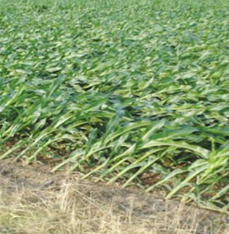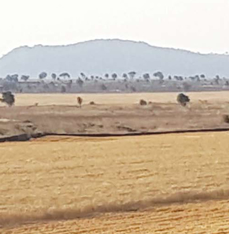Maize Lodging
 Stalk lodging by definition is the breakage of the stalk below the ear. Severely lodged maize leads to increased harvest losses, increased harvest time, increased drying cost and may result in volunteer crops the following year. Lodging in maize crop is as a result of many biotic and abiotic factors.
Stalk lodging by definition is the breakage of the stalk below the ear. Severely lodged maize leads to increased harvest losses, increased harvest time, increased drying cost and may result in volunteer crops the following year. Lodging in maize crop is as a result of many biotic and abiotic factors.
Soil compaction might be the major cause due to the overuse of tractors during land preparation and planting. Soil compaction prevents roots penetration making the crop to be poorly anchored in the soil.
Farmers who experience such challenges should conduct both Pathology and Nutrition Test.
1. Nutrition Test:
• Soil Acidity - It is all known that the soils in Kenya’s maize growing regions like Uasin Gishu are acidic and this results to poor roots growth and development.
• To ascertain the Nitrogen Levels and Potassium Levels – High Nitrogen in relation to potassium levels cause lodging in corns. Potassium imparts resistance to lodging by increasing the rind thickness and crushing strength.
Read more ...
Briefs - April - June 2019
Monsanto Fund Is Renamed Bayer Fund
As Bayer Fund, the charitable organization will continue its mission to support organizations and programs in the communities served by the Monsanto Fund.
Monsanto Fund, which was established in 1964, will now be known as Bayer Fund.
As Bayer Fund, the charitable organization will continue to provide sustainable assistance focused on priority giving in the areas of food and nutrition, STEM (Science, Technology, Engineering and Mathematics) education, and community development.
Under its new name, Bayer Fund will continue to operate as a separate 501(c)(3) non-profit organization.
“Changing the name to Bayer Fund represents the next step in our transition and alignment with Bayer while maintaining our philanthropic mission,” said Al Mitchell, Bayer’s Vice President of Community Engagement.
All current philanthropic commitments that have been made by Monsanto Fund will not be impacted by the name change, and all new grants awarded will be made under the Bayer Fund name. In 2018, more than $18 million in grants were awarded to organizations globally in communities where Bayer employees live and work.
About Bayer Fund
Bayer Fund is a nonprofit organization dedicated to strengthening the communities where Bayer customers and employees live and work by providing funding for food and nutrition, education and community development projects.
About Bayer
Bayer is a global enterprise with core competencies in the life science fields of health care and nutrition. Its products and services are designed to benefit people by supporting efforts to overcome the major challenges presented by a growing and aging global population. At the same time, the Group aims to increase its earning power and create value through innovation and growth. Bayer is committed to the principles of sustainable development, and the Bayer brand stands for trust, reliability and quality throughout the world. In fiscal 2018, the Group employed around 117,000 people and had sales of 39.6 billion euros. Capital expenditures amounted to 2.6 billion euros, R&D expenses to 5.2 billion euros. For more information, go to bayer.com.
Screening Cycle for Deadly MLN Virus Set to Begin in Kenya During 2019
The maize lethal necrosis (MLN) artificial inoculation screening site in Naivasha, Kenya, will begin its phenotyping (screening/ indexing) cycle of 2019 at the beginning of January 2019 and in other four intervals throughout the year. Interested organizations from both the private and public sectors are invited to send maize germplasm for screening. In 2013, the International Maize and Wheat Improvement Center (CIMMYT) and the Kenya Agricultural & Livestock Research Organization (KALRO) jointly established the MLN screening facility at the KALRO Naivasha research station in Kenya’s Rift Valley with support from the Bill & Melinda Gates Foundation and the Syngenta Foundation for Sustainable Agriculture.
MLN was first discovered in Kenya in 2011 and quickly spread to other parts of eastern Africa; the disease causes premature plant death and unfilled, poorly formed maize cobs, and can lead to up to 100 percent yield loss in farmers’ fields. CIMMYT and partners are dedicated to stopping the spread of this deadly maize disease by effectively managing the risk of MLN on maize production through screening and identifying MLN-resistant germplasm. The MLN screening facility supports countries in sub-Saharan Africa to screen maize germplasm (for hybrid, inbred and open pollinated varieties) against MLN in a quarantined environment.
This is the largest dedicated MLN screening facility in East Africa. Since its inception in 2013, the facility has evaluated more than 180,000 accessions (more than 270,000 rows of maize) from more than 15 multinational and national seed companies and national research programs. Partners can now plan for annual MLN Phenotyping (Screening / Indexing) during 2019 with the schedule below. The improved and streamlined approach for MLN phenotyping should enable our partners to accelerate breeding programs to improve resistance for Maize MLN for sub-Saharan Africa.
2019 annual phenotyping (indexing / screening) schedule:
| When the seeds are available |
Planting Period – Planned |
MLN Screening/ Indexing |
| December |
Second Week of January |
MLN Indexing |
| March |
Second week of April |
MLN Screening |
| June |
Second Week of July |
MLN Indexing |
| August |
Second Week of September |
MLN Screening |
| October |
Second week of November |
MLN Indexing |
Rising maize flour prices; Real or Artificial
That maize flour prices have risen by up to 28 percent points to a perennially chaotic grains market and failing food security strategies that need to be re-examined comprehensively. The millers attributing the increased prices to reduced supply of grain in the market.
This is curious, coming just months after the country reported a bumper harvest of 40 million bags of maize in 2018, the highest production in the last three years. It also comes against the government disclosure last month that there were 46 million bags of maize in the country held by millers, farmers as well as relief and humanitarian agencies.
Clearly there is distortion of sorts in the grain markets that must be addressed because there is maize in this country and sharp increases in the price of flour only reveal that there is a problem in the supply chain. Farmers have in the past complained of unfair pricing by the State, which buys maize through the National Cereals and Produce Board (NCPB). Brokers too offer below market prices, especially soon after harvests. This has often led farmers to hoard their stocks with hope of landing better prices. Because of the lacuna, cartels have also thrived in the grains market by creating artificial shortages to enable them profiteer through importation as witnessed in the 2017-2018 window when they flooded the local market with imported stocks at the expense of farmers who remained stranded with produce. Such scenarios distort the market and it is only proper that the State reached a lasting deal with local maize farmers so that they are compensated fairly for their effort and investment to avoid intermittent hoarding of stocks.
Cartels have taken advantage of the feuds between the government and farmers to press for importation of maize under the guise of bridging shortages in the market. This should not be allowed to happen. The government should enter negotiations with farmers and mop-up all the locally available maize to stabilise prices. Or the market for grain should be left to the free market, so that farmers can negotiate directly with millers.
The cyclical trend of mysterious shortages of maize should end. However, this would only be possible through proper planning and close monitoring of the grains market.
 This means an excess of $83 billion in food security and enterprise opportunities lost each year in Africa. The implication is simple — that solutions to Africa’s food insecurity cannot be found by focusing on agriculture as a silo. The solutions lie in value addition, where key enablers like decentralising clean energy to power value addition while ensuring we don’t pile on the emission responsible for climate change that threatens to lower yields by up to 40 per cent is critical. So how can these solutions be unlocked?
This means an excess of $83 billion in food security and enterprise opportunities lost each year in Africa. The implication is simple — that solutions to Africa’s food insecurity cannot be found by focusing on agriculture as a silo. The solutions lie in value addition, where key enablers like decentralising clean energy to power value addition while ensuring we don’t pile on the emission responsible for climate change that threatens to lower yields by up to 40 per cent is critical. So how can these solutions be unlocked? In Canberra on Nov. 30, leaders of three CGIAR centers gathered to talk about global food systems as part of a forum on transforming global food systems hosted by the Australian Centre for International Agricultural Research. The message on climate was consistent: Food security is critical to the achievement of the Sustainable Development Goals. But climate change is creating a risk that is growing rapidly. “One of the biggest issues in the use of averages is that it hides the real story of climate change. The real story is around the variability and unpredictability of weather.”— Matthew Morell, director general, International Rice Research Institute Martin Kropff, director general of the International Maize and Wheat Improvement Center, and Matthew Morell, director general of the International Rice Research Institute, spent their time visiting Australian research institutes and presenting at a range of forums. As part of their visit, they spoke to Devex about the limits of agricultural research, and why we may be fast hitting barriers of how science can solve food crises in a fast-changing environment.
In Canberra on Nov. 30, leaders of three CGIAR centers gathered to talk about global food systems as part of a forum on transforming global food systems hosted by the Australian Centre for International Agricultural Research. The message on climate was consistent: Food security is critical to the achievement of the Sustainable Development Goals. But climate change is creating a risk that is growing rapidly. “One of the biggest issues in the use of averages is that it hides the real story of climate change. The real story is around the variability and unpredictability of weather.”— Matthew Morell, director general, International Rice Research Institute Martin Kropff, director general of the International Maize and Wheat Improvement Center, and Matthew Morell, director general of the International Rice Research Institute, spent their time visiting Australian research institutes and presenting at a range of forums. As part of their visit, they spoke to Devex about the limits of agricultural research, and why we may be fast hitting barriers of how science can solve food crises in a fast-changing environment. Stalk lodging by definition is the breakage of the stalk below the ear. Severely lodged maize leads to increased harvest losses, increased harvest time, increased drying cost and may result in volunteer crops the following year. Lodging in maize crop is as a result of many biotic and abiotic factors.
Stalk lodging by definition is the breakage of the stalk below the ear. Severely lodged maize leads to increased harvest losses, increased harvest time, increased drying cost and may result in volunteer crops the following year. Lodging in maize crop is as a result of many biotic and abiotic factors.